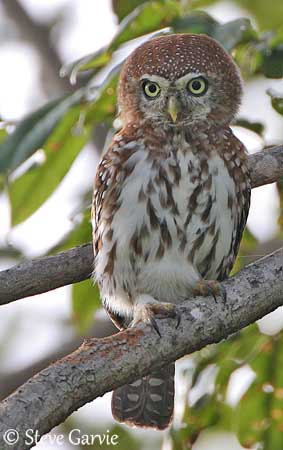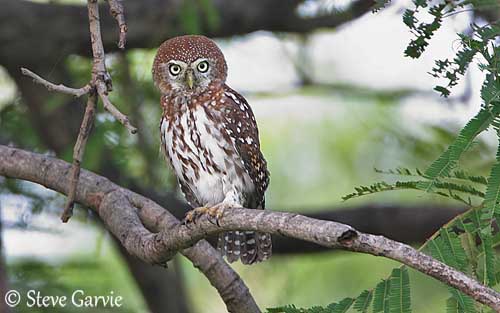
Fr: Chevêchette perlée
All: Perlkauz
Esp: Mochuelo Perlado
Ital: Civetta nana perlata
Nd: Geparelde Dwerguil
Sd: Pärlsparvuggla
Photographers:
Steve Garvie
RAINBIRDER Photo galleries
Callie de Wet
GALLERY
Text by Nicole Bouglouan
Sources:
HANDBOOK OF THE BIRDS OF THE WORLD Vol 5 by Josep del Hoyo-Andrew Elliott-Jordi Sargatal - Lynx Edicions - ISBN: 8487334253
BIRDS OF THE GAMBIA AND SENEGAL by Clive Barlow and Tim Wacher – Helm Field guides – ISBN: 0713675497
BirdLife International (BirdLife International)
Pearl-spotted Owlet
Glaucidium perlatum
Strigiforme Order – Srtigidae Family
INTRODUCTION:
This small and stocky owlet shows very peculiar nape pattern, with two dark spots surrounded by white rim, described as “eye-spots” or “false-eyes”. This distinctive pattern is used by the owlet to escape predators, as it appears larger than it really is.
Like all Glaucidium members, the Pearl-spotted Owlet is a very small, tiny bird. It is living in Africa, south of Sahara.

DESCRIPTION OF THE BIRD:
Biometrics:
Length: 17-20 cm
Wingspan: 40 cm
Weight: M: 36-86 g – F: 61-147 g
The adult of nominate race has chocolate-rufous plumage, mostly cinnamon-brown spotted white on back. The fairly long brown tail is narrowly barred white. The flight feathers are dark brown barred pale rufous.
On the underparts, breast and belly are white streaked dark brown, with heavier streaking on breast.
On the rounded head, the ear-tufts are lacking. The head is cinnamon-brown with whitish facial disk edged brown. The white eyebrows are conspicuous. The crown is finely spotted white, giving the bird its name. The nape shows two typical “eye-spots” with dark centre and white rim.
The bill is pale yellow horn. The eyes are yellow. The feathered tarsi are whitish and the feet are dull yellow.
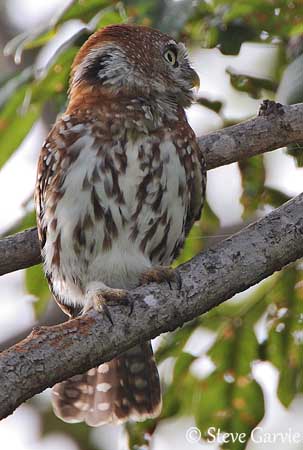
Both sexes are similar, with the female slightly larger than male.
The juvenile is duller, less rufous, less spotted on mantle and crown. It has shorter tail too.
SUBSPECIES AND RANGE:
We can find two subspecies:
G.p. perlatum (here described and displayed) is found in Senegambia to W Sudan, and possibly in Liberia too.
G.p. licua occurs in E Sudan, Ethiopia, S to N and E South Africa, Angola and Namibia. This one is greyer than nominate, and more heavily spotted.
HABITAT:
The Pearl-spotted Owlet frequents lightly wooded areas, open woodland and grassland, but also forest and dense woodland. It avoids moist forest and most arid areas.
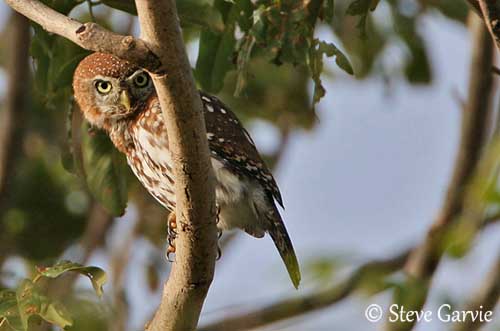
CALLS AND SONGS: SOUNDS BY XENO-CANTO
The Pearl-spotted Owlet is mainly vocal after dark. It gives series of far-carrying rising whistles, ending in longer, descending notes “tu-tu-tu-tu-tu-tu-twee-twee-twee”.
The alarm call is a repeated “peep-peep-peep”. It also gives a squeaky high-pitched note during the day. Mates frequently perform duets.
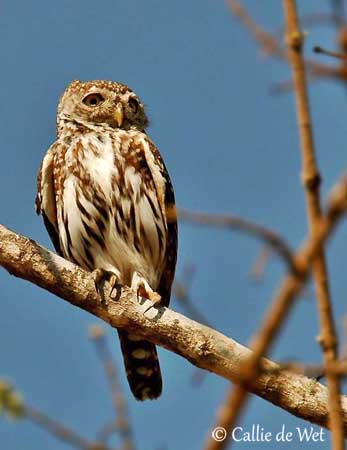
BEHAVIOUR IN THE WILD:
The Pearl-spotted Owlet feeds primarily on arthropods, but it also takes larger preys such as bats, birds, rodents and lizards. Although being the most diurnal African owl, this species hunts usually at night, and sometimes by day.
It hunts from a perch, searching for preys on the ground. Once the prey is detected, it dives fast to strike. It is able to kill larger birds such as Columbidae, thanks to its powerful feet.
The “false-eyes” are used for surprise attacks, while the prey believes it is looking away. But this morphological feature is also used to discourage the predators coming from behind.
The Pearl-spotted Owlet also pursues preys in flight, and may sometimes steal food from other birds’ species or rob nest holes. It also eats carrion.
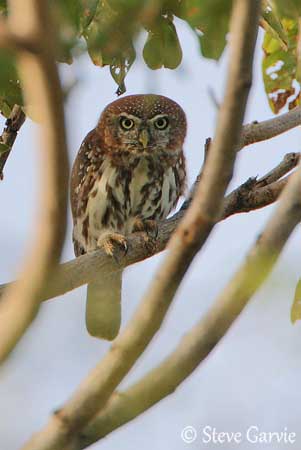
While hunting, it bobs the head up and down and flicks nervously its tail. When alarmed, it repeats these postures and arches the wings too.
As resident in its range, the Pearl-spotted Owlet is territorial all year round. During the breeding season, both sexes call in duets. Courtship feeding by male to female is observed too, often prior to copulation. While presenting food to the female, the male performs wing- and body-movements.
They nest in natural cavities, especially old holes of barbets and woodpeckers. It may ravage these nests too to gain site. However, its own nest is sometimes usurped by other cavity-nesters or bees!
The Pearl-spotted Owlet has fast and deeply undulating flight.
REPRODUCTION OF THIS SPECIES:
The laying occurs between August and November, with a peak in September/October.
The Pearl-spotted Owlet nests in cavities such as abandoned nests of barbet or woodpecker. The cavity is usually placed between 2 and 10 metres above the ground. The nest-site can be reused during several years.
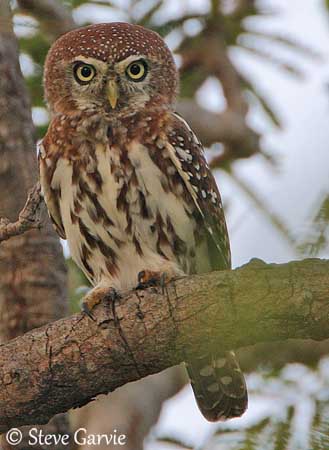
The female lays 2-4 eggs and incubates during one month, while the male feeds her. If the female is disturbed at nest by an intruder or a predator, she lies flat on the ground. Thanks to her cryptic plumage and the “eye-spots”, she becomes similar to plant debris. The chicks are covered with white down. They fledge about 31 days after hatching. The pair rarely raises the full clutch.
PROTECTION / THREATS / STATUS:
The Pearl-spotted Owlet is widespread or locally common in some parts of the range. This species is not threatened by the usual degradation of habitat and deforestation. However, the western populations are less abundant and appear more vulnerable to changes in habitat and food resources.
But currently, the Pearl-spotted Owlet is not threatened.
